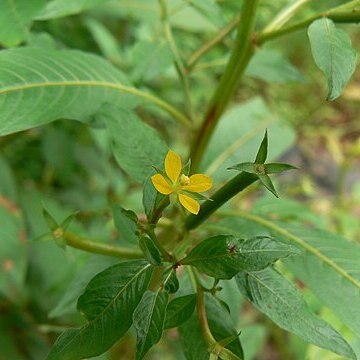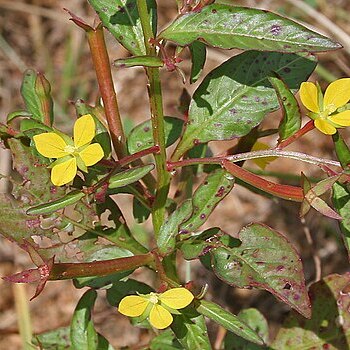Herbs erect, annual, with taproot. Stems 20-100 cm tall, branched, subglabrous or minutely puberulous on younger parts. Petiole 2-15 mm, winged; leaf blade narrowly elliptic to lanceolate, 1-11 × 0.3-2.7 cm, lateral veins 6-12 per side, submarginal vein inconspicuous, base narrowly cuneate, apex subacute. Sepals 4, rarely 5, deltate, (1.3-)2-3.5 mm, glabrous or minutely puberulous. Petals yellow, elliptic, 1-3 × 0.7-2 mm. Stamens as many as sepals, or rarely more; filaments 0.3-0.7 mm; anthers 0.5-0.7 mm; pollen in tetrads. Style 0.7-1.5 mm; stigma globose. Capsule often nodding, pale brown, oblanceoloid, terete, 3-16(-19) mm, 2.5-5 mm in diam., thinly walled, readily and irregularly loculicidal, glabrous or puberulous, sessile or pedicel to 6 mm. Seeds in 2 or more rows per locule, free, brown with fine brown lines, 0.3-0.5 mm, raphe very narrow and inconspicuous. Fl. and fr. Jul-Nov. 2n = 16.
Erect, annual herb to 1 m high, usually subglabrous. Leaves alternate, narrowly elliptic to lanceolate, 1–10 cm long, subacute, narrowly cuneate at base; subsessile or with petiole to 2 cm long. Flowers many, usually solitary in consecutive leaf axils; bracteoles minute or absent. Sepals 4, rarely 5, deltoid. Petals 1–3 mm long, yellow. Stamens as many as sepals. Capsule 3–20 mm long, terete, readily and irregularly dehiscent. Seeds in each locule in several rows and free.
Capsule 3–16 (19) mm. long, thin-walled, glabrous or puberulent, terete, pale brown, readily and irregularly loculicidal; capsule sessile or on a pedicel up to 6 mm. long, often more or less nodding.
Leaves 1–11 × 0·3–2·7 cm., narrowly elliptical to lanceolate, narrowly cuneate at the base, the apex subacute; main veins on each side of the midrib 6–12; petiole 2–15 mm. long, winged.
A herb. It is erect and grows each year from seed. The stems are 20-100 cm tall. The leaves are sword shaped and 1-11 cm long by 1-3 cm wide. The flower petals are yellow.
Seeds 0·3–0·5 × 0·2–0·25 mm., pluriseriate in each locule of the capsule, free, brown with fine brown lines, ellipsoid-rounded; raphe very narrow and inconspicuous.
Stamens usually as many as the sepals, rarely more; filaments 0·3–0·7 mm. long; anthers 0·5–0·7 × 0·5–0·7 mm., shedding pollen directly on the stigma at anthesis.
Sepals 4, rarely 5, (1·3)2–3·5 × (0·5) 0·7–1·8 mm., deltate, glabrous or minutely puberulent.
Annual herb up to 1 m. tall, subglabrous or minutely puberulent on younger parts.
Style 0·7–1·5 mm. long; stigma 0·4–0·5 mm. thick, globose.
Petals 1–3 × 0·7–2 mm., elliptical.
Disk slightly elevated, glabrous.
Pollen shed in tetrads.



